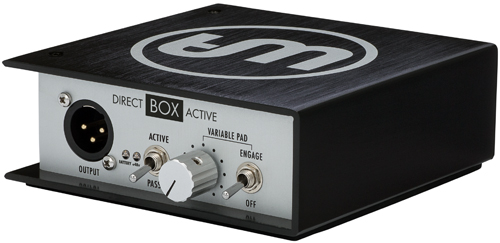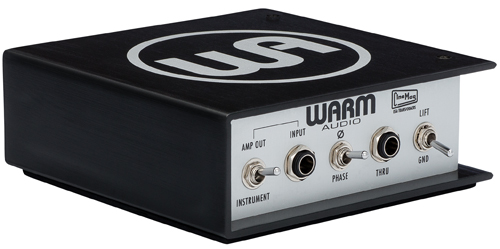|
|
Warm Audio Direct Box Active and Direct Box Passive
|
|
|
 |
| Warm Audio Direct Box Active |
Warm Audio introduces two new direct injection or DI boxes that both provide pristine conversion between low-level high impedance sources and professional audio low impedance microphone inputs in the studio or for live performance stages.
You'll always need a DI for a direct connection to a PA system and/or for recording in the studio. You can DI: electric guitars, basses, electronic keyboards or that drum machine. Besides impedance conversion, a good direct box provides isolation from ground loops, stray hum or noise that will corrupt the lower level signals coming from guitars and basses.
Both these new Active and Passive DI boxes have an onboard -3dB to -30dB signal attenuator called a Variable Pad that means any audio signal can be interfaced without overload. This is a good, extra feature not usually found on DI boxes for connecting synthesizers or preamps that can distort next in the chain with excessive level.
This is also a new feature for a passive direct box too and Warm has provided an Engage/Off switch to instantly switch in a control knob for this Variable Pad. The lowest setting is -3dB (the insertion loss for a passive control) so I wasn't fooled into thinking I lost signal level. These controls are conveniently located on one side of the boxes next to the XLR output connectors. This control is easily turned; I'd like to see detents and a way to lock down whatever setting you want dialed.
The main difference in using either an Active or Passive DI box depends completely on the source. Simple passive guitar pickups or piezoelectric transducers placed inside of acoustic guitars--instruments without any onboard electronics/amplifier/EQs sound best using an active DI box. You'll have more level to work with and a clearer sound. Warm Audio's Direct Box Passive is better for instruments with active electronics--basses and guitars. I always found using an active DI with a guitar with an active preamp sounded like too much activity! Not great!
 |
| Warm Audio Direct Box Passive |
I first used the Warm Audio Direct Box Passive for recording my Fender Stratocaster here at my studio and also later a P-Bass and yes, I got great clean and noise-free sound in both tests. I also tried the Warm Audio Direct Box Active first in passive mode and then in Active. There is the same circuit and transformer as the Passive model.I was surprise to hear no change in volume switching between the two (and a sign of proper design)--the Active Direct Box has two 9-volt batteries inside to power it or you can use the 48-volt phantom powering from your mic preamp.
On the Direct Box Active I liked the small LEDS to indicate when 48-volts is present on the XLR and another indicates that a fresh set of batteries are installed.
Other features the two shared are: identical custom-wound CineMag USA transformers, ground lift switch, a 1/4-inch Thru jack to pass the instrument's signal to a live amp, polarity switch, and an Amp Out/Instrument toggle switch to use the output speaker jack of a stage amp.
Both the Direct Box Passive and Direct Box Active are built in extruded aluminum boxes that appear to be crush proof--considering where DI boxes are located in live sound and in the studio--they have to be!
They each have a balanced 600-ohm output at pro mic level, a high input impedance of 1 meg-ohm and a frequency response of 20Hz to 70kHz with less than .004% total harmonic distortion from 100Hz to 20kHz, and .01% from 20Hz to 100Hz.
The Warm Audio Direct Box Active sells for $199 MAP while the Direct Box Passive is $149 MAP.
|
|
|